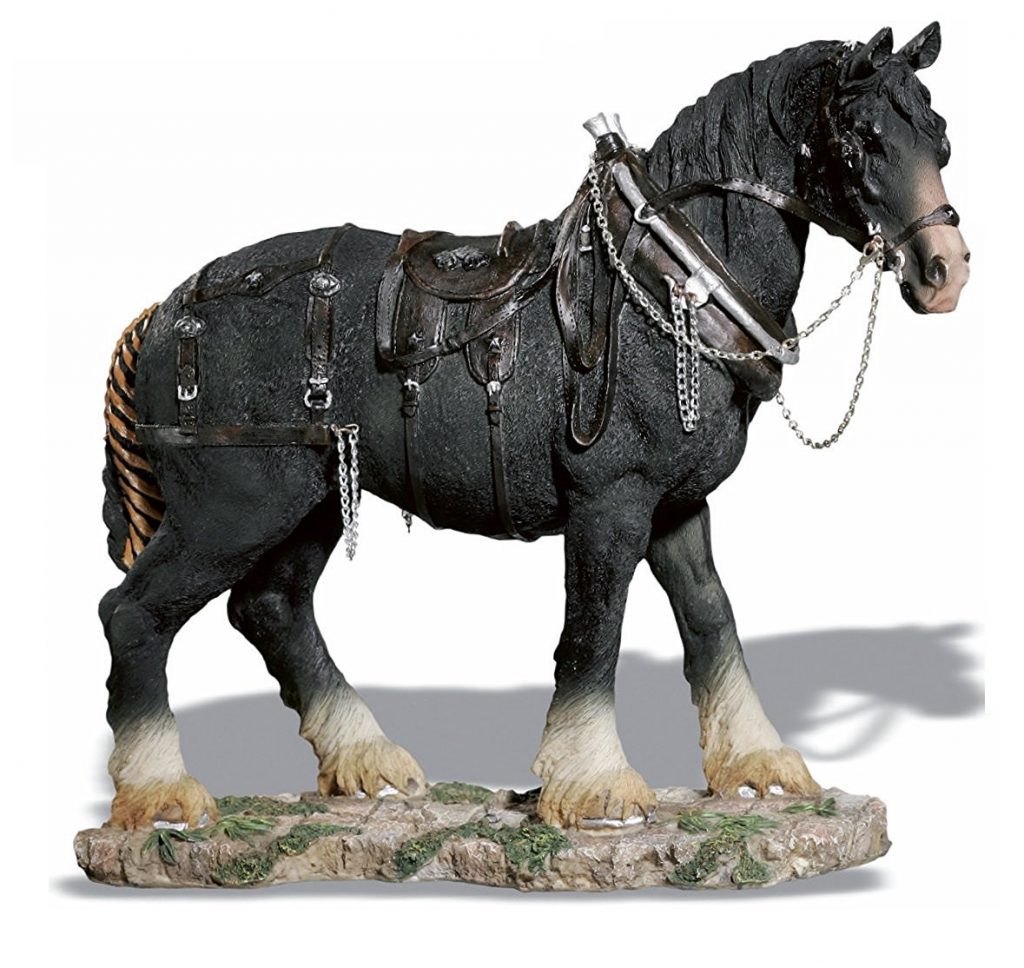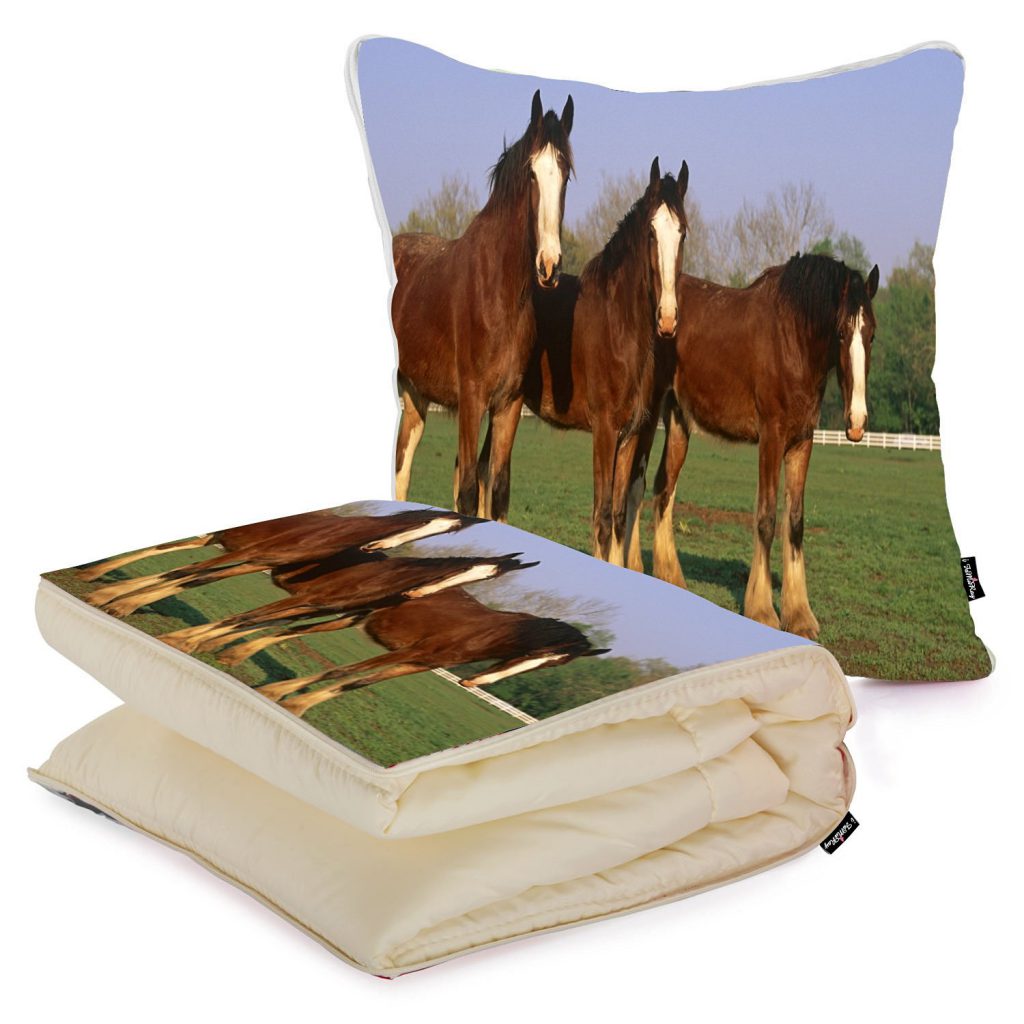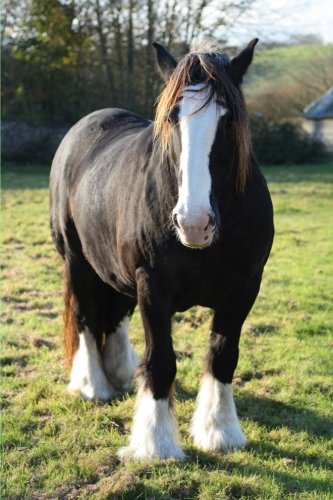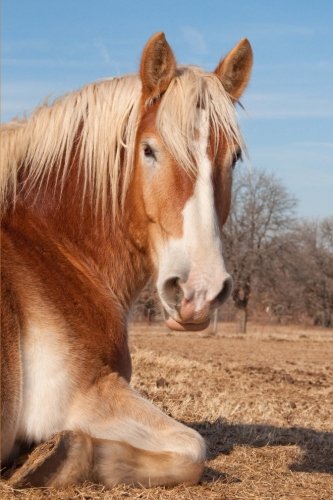Draft or large horses weighing up to 2000 pounds. They are strong with large bones and sturdy legs. Some examples are: Percherons, Clydesdale, Shire, Belgian and Suffolk horses.
Percherons

The Percheron is a horse breed developed in the Huisne river valley in France, which was previously known as Perche. Originally bred as a war horse, the Percheron is known for its strength, intelligence, and work ethic, which makes it a historically popular breed.
Percherons are bred primarily in the United States, France and Great Britain for the purposes of draft work and as show horses.The Percheron has a very pleasing disposition. He is proud, alert, intelligent and willing worker.
Percherons are usually black or grey, but there are also sorrels, bays, roans, etc. Many Percherons have white markings on the head and feet, but excessive white is undesirable. Percherons range in height from 15 to 19 hands high, most are between 16-2 and 17-3 hands high. They can weigh up to 2600 pounds with the average around 1900.
Percherons are noted for heavy muscling in the lower thighs and for an aspect of unusual ruggedness and power. Also characteristic of the Percheron is the clean action and quality conformation of the feet and legs.
An ideal horse should have a fairly long level croup with a big round hip. He should be close coupled and wide and deep through the chest, with plenty of back rib. The muscles of the arms, forearms, croup and gaskins plenty are especially emphasized in a good drafter, and ease and balance of gait is essential. He is also expected to be of marked tractability and an easy keeper.
The Percheron head and neck are typical of the most attractive draft horse character. Good Percherons have a large and full prominent eye, a broad and full forehead, and straight face. His strong jaw and refined ears attractively set and carried with animation, suggests his arabian ancestry. Stallions should have a ruggedness about the head and mares should have a feminine look.
The Percheron is very versatile. They are readily adapted to varying climates and conditions. They have the strength to pull heavy loads and the graceful style to pull a fine carriage. Percherons can be ridden and some have been known to make fine jumpers.
The Percheron is very handy in saving the young trees in smaller wood lot operations as they do not need a wide road everywhere they work. They can get on and work ground where even the most modern tractors fail. Their independent four wheel drive conquers mud and snow to the shame of all man made machines. There is a definite place on almost every farm for a team of Percheron horses, whether it be for work or play.
Clydesdale

i FaMuRay Custom Throw Pillow and Travel Blanket Set 2 in 1, Clydesdale Horses
From their use as warhorses in the 17th century to their work in advertising today, the Clydesdale horse breed has undergone powerful changes. In Clydesdale, Scotland, now known as Lanarkshire, the animal was named for the town where it was used as a draft horse on area farms. Believed to have a history of over 300 years, this strong yet amiable animal was used in farming as well as pulling heavy loads in rural settings, as well as is urban and industrial areas.
The Clydesdale horse breed is best known for its size, over 18 hands, about six-feet and the feather above the hooves. This long hair covering their ankles makes this breed easily recognizable and it is thought the feather was developed during the first breedings with the Fleming and English Breeds. This feather, a thick mane and heavy coat helped the breed survive in the Scottish climate.
Coloring of the Clydesdale horse breed varies from different shades of bay, brown, chestnut and black, predominantly with one solid color, often with a white underbelly as well as a white feather.
Although horses with black legs may sometimes also offer a black feather. Originally developed for protection against harsh weather, the feather is mainly for show.
Horses with a white muzzle typically have black spots around the chin and lips and a white mask usually covers the face. White feet may extend up to merge with the white underbelly, they can also end at the top of the feather. Another characteristic of the Clydesdale horse breed are black and white striped hooves.
Traditionally used for heavy labor, the Clydesdale horse breed has been mostly replaced by tractors and other machinery except by farmers who reject the industrial way of life and on eco-friendly farms, as well as in some remaining logging operations.
Shire

The Shire Horse Journal: 150 page lined notebook/diary
A true “gentle giant”, the Shire is renowned for its docile temperament and strong work ethic. From battlefield to farmland, this noble horse has been a well mannered servant and faithful companion. The Shire’s great ancestors came from the “Old English Black Horse” of the central regions of England, counties commonly referred to as the “shires”.
Though its ancestry dates back to the Great Horses of the Medieval era, its use throughout history is one of aiding in the civilization of modern man. In the twelfth century, these heavy cob type horses were used as warhorses. Being strong and docile they were well suited to carrying the three hundred or so pounds of a fully armored knight into battle. Then farmers found their worth, being able to pull farm equipment and clear marshlands.
The Shire is a Draft Horse or Heavy horse. The Draft horse is also known as the Draught Horse or Dray Horse. ‘Dray’ is a word derived from the Anglo-Saxon term for ‘to haul’ or ‘to draw’.
The heavier draft horses were developed from the bulkier type of equines found in the northern hemisphere. These hardy horses evolved to survive in a colder harsher climate, and are much heavier and broader than the light horses. The breeds in this horse class are referred to as cold blood breeds, in reference to their quiet and calm temperament. They are heavy in the body, strong legged, and often have “feathers”, or long hair, covering their large hooves.
Shire horses are big eaters and should have plenty of fresh hay and clean water available. They have feathered ankles, making good grooming and sanitary conditions essential to avoid pododermititis, or “scratches” (a bacterial infection of the ankle).
The Shire horses are large and need adequate room to move around. If kept in stalls, be sure the stalls are large and well bedded enough to be comfortable for the horse.
This horse is noted for a quiet and calm temperament. Its great strength and docile nature makes horse training for this breed suitable in a variety of disciplines beyond just horse riding. well suited for many disciplines. The Shire has been successful in driving, jumping, dressage, and trail riding; all due to its tractable nature and trainability.
Belgian

The Belgian Draft Horse Journal: 150 page lined notebook/diary
The Belgian draft horse was developed in the fertile pastures of Belgium. It was also there that the forefather of all draft horses was first bred—a heavy black horse used as knights’ mounts called the Flemish.The Belgian draft horse developed from this horse and carries many characteristics of the Flemish even today.
The Belgian was primarily used for farm work but also in cities to work alongside other draft breeds in warehouses, freight stations and fishing wharfs. In 1866, the first Belgian arrived on American soil. In 1885 men in Wabash, Ind., started a business importing Belgian stallions and selling them to horse breeders throughout the Midwest. Today, the horses are used for hobby and historical farming, forestry work and pleasure driving.
It is a docile horse and a willing worker. The American Belgian has a relatively large head and short, feathered, muscular legs and large quarters. The feet are large and have minimum feather. Its colour is usually chestnut or roan with white or blonde mane, tail and points. Its weight averages between 1800 and 2000 pounds; some stallions reach 2400.
The Belgian horse is the strongest and most powerful of all the draft horse breeds in the world. In addition to being the strongest, these horses also hold the record for being the tallest and largest horses in the world.
The height of an average Belgian horse is between 15.3-17.3 hands. However, the current record holder for the tallest horse is Radar who stands around 19. 3 hands tall.
The head of the Belgian horse is square with either a straight or slightly concave profile. Their short neck is muscular. They have a wide back which is short. The body is short and has a deep girth. They have strong legs that are lean and have medium to heave feathering. These horses have a good gait. Their action is well suited for draft work which is what they are made for.
The Belgian horses are intelligent animals. They are also well known for their kindness and docility. They are hard working creatures and willing to please.
The advent of mechanization and industrialization post World War II led to the decline in the number of Belgian Horses. However, in modern times, there has been an increased level of interest for this breed in America which is helping in bringing up their numbers slightly.
If you have any information,questions, or feedback you would like to include in this webpage.
Please email momo19@naturekingdoms.com or leave your comments below.